Less straightforward modifications
Modification 1: Driver stage
The first major modification to the amplifier is based on an article of Peter van Willenswaard, published in a (discontinued) Dutch audio magazine, called Audio en Techniek, issue 49 and 50. This article describes the modification of a Philips 309 amplifier, which is a push-pull amplifier based on EL-84 output tubes. The modification is based on combining a driver stage with a paraphase phase shifter, as shown in his schematic below.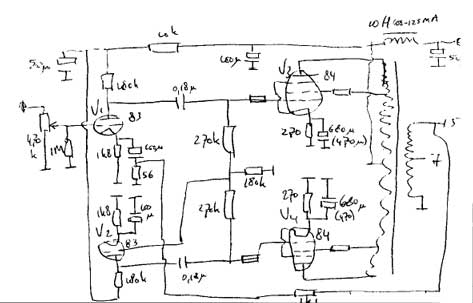
The idea of this circuit very much resembles the circuit, published in the 60s by a Dutch DIY magazine called Radio Bulletin. The design is knows as the HV-211. The (non-detailed) schematics are shown in the picture below.
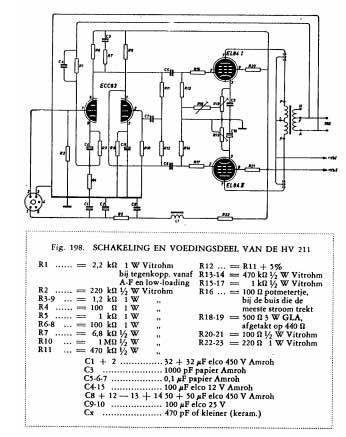
For the Classic this means that the driver tube disappears, and we should be concerned if an ECC83 on itself is capable of steering an EL-34 in triode mode. Cg1 of an EL-34 in triode mode is 15.5pF. We want to keep the attenuation at 20kHz limited, say 10% attenuation as a maximum, which gives a minimum value for the resistors in the phase splitters of 223kOhm.. We choose 270kOhm.
Measurements afterwards showed that treble was about -3dB down somewhere between 12 and 15kHz, caused by the capacitive load of the EL-34s. What's going on? Well, the carefull reader could have observed that although Cg1=15.5pF, it should be multiplied by the gain of the EL-34 plus 1 to obtain the Miller capacity. Hence, in my calculation, I was a factor of sqrt(6) (roughly 2.5) wrong. That's a lot, and that's audible.
At the expense of some gain, and without influencing the operating point of the ECC83s, this can be compensated by adding a 100kOhm resistor between both anodes of the driver tubes (the DC voltage doesn't change because the design is balanced, but for AC it does), a rather smart idea of Jos van Eijndhoven. It reduces the output impedance by a factor of 1.65, which brings the -3dB point at roughly 25kHz. Although it works satisfactory, this is just a patch for sure.
After building, measurements showed that the grid of the EL-34 influences the phase shiter in its DC behaviour. Therefore a capacitor has been positioned between the virtual ground and the grid of the phase shifter. The modifications to the schematics for the Classic are (roughly!!!) as follows:
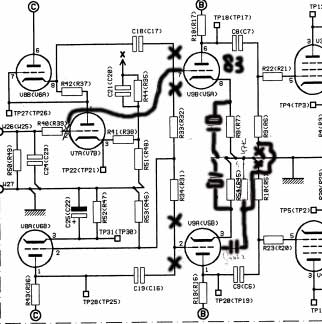
The input stage is bypassed, and the driver stage is rebuilt a bit to obtain Peters' circuit. Look at the schematics of the final circuit for the values of all the components:
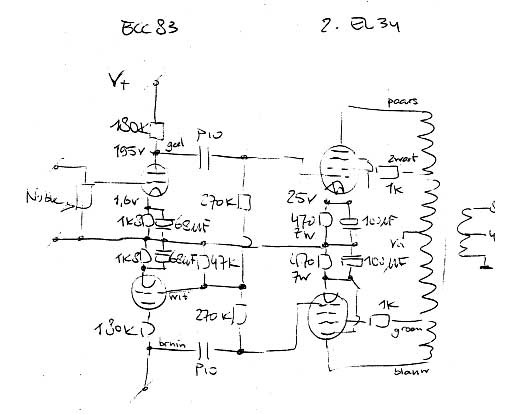
The power supply is modified as follows, to change the fact a whole stage has been eliminated.
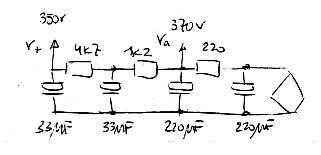
Observations
I haven't looked into depth why this circuit is so nice sounding (some will say it's because a lot of electronics is skipped, others will say it's the topology, and again others will say it's distortion), and I'm not going to make pseudo technical statements about it. Just like Peter and others say in his original article, after this modification the amplifier is sounding more like a well developed single-ended triode amplifier. It's more refined, it has a very open 3D perspective, and an authority/silence which is breathtaking. It's a very step forward w.r.t. the original circuit, and I'm very enthousiastic about this step. Recommended!!!
Modification 2: Common ground
Some underlying thoughts for the modification discussed on this web page, can be found in a pdf article by Robert Mitchell. It considers different ways of applying cathode resistors in push-pull circuitry:- By-passed with a capacitor or not?
- With a common resistor and coupled cathodes, or with two separate resistors.
The original Classic 25 uses seperate resistors, both bypassed with a capacitor. The proposed modification suggests a common resistor, with no decoupling. The modification can be carried out very easily, as shown in the following scheme.

Observations
The modification has been applied in two stages. Firstly, the modification has been applied to the driver stage. This resulted in a cleaner treble, an better diffuse field. The same mod applied to the EL-34s resulted in more punch in the bass, and - quite weird - the idea that the amplifier can play at least twice as hard, much more dynamic. This effect can even be extended by lowering the common (resulting) Rk of the EL-34s, e.g. by paralleling 1000 Ohm, resulting in say 195 Ohm.Although the treble is cleaner, it might not be as smooth as it has been, so there is a trade-off.
next->